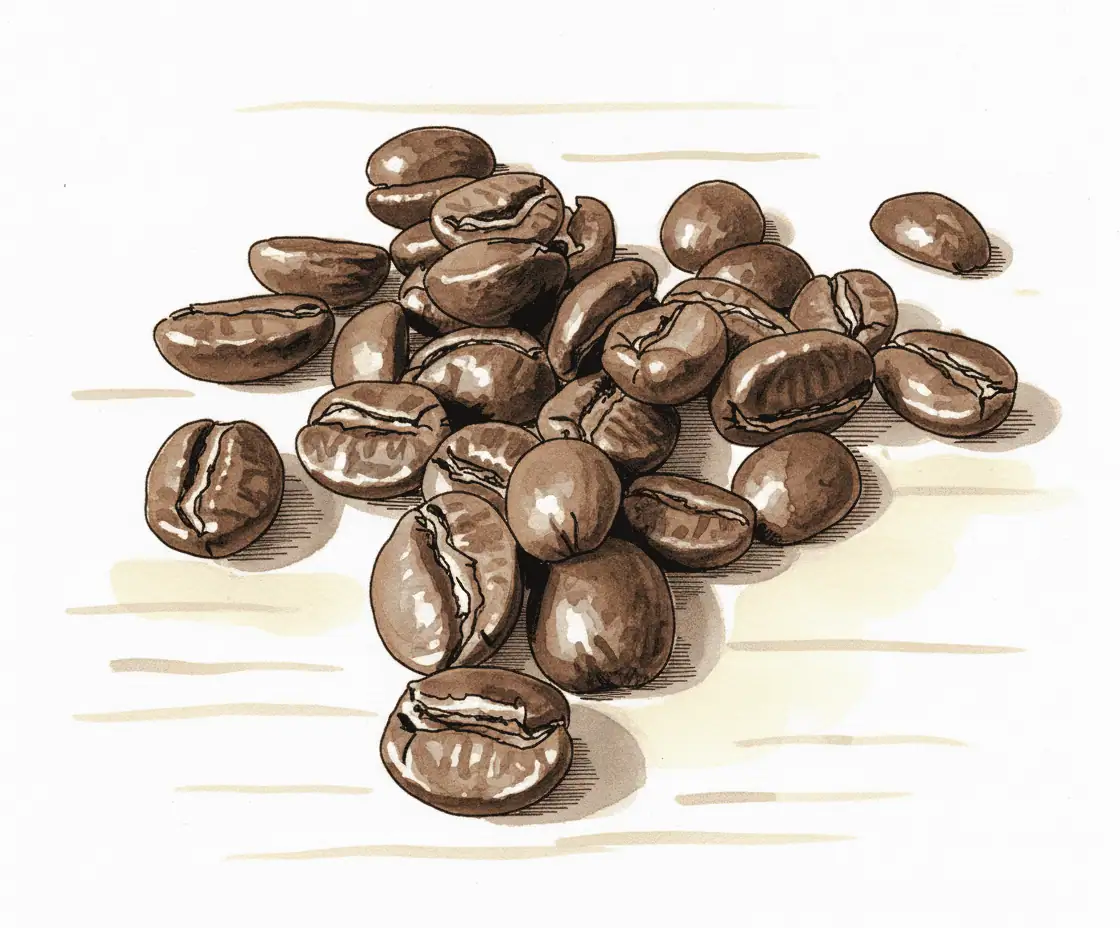Average altitude
Mid altitudes (around 1200–1500 meters) produce beans that offer a balance between sweetness and acidity. Growing conditions are still mild, yet the beans often develop more refinement than at lower elevations. This results in a brighter flavor profile, sometimes with subtle fruit or floral notes. Mid-altitude regions are common in countries such as Colombia, Mexico, and parts of Central America.
Beans

Espresso Italiano
Espresso Italiano from CoffeeXperts is a medium to dark roast with a silky crema and caramel-like sweetness. The blend combines Arabica beans from Brazil, Costa Rica, Guatemala, and Java, processed through natural, washed, and wet hulled methods. Expect notes of bitter chocolate, nuts, cocoa, vanilla, and a touch of citrus, beautifully balanced between bitter and sweet...

Espresso roast, Indonesia, Flores laga lizu
Flores Laga Lizu komt uit de Bajawa regio op Flores, waar koffie op vulkanische bodems groeit tussen gember en andere gewassen. De espresso roast is ontwikkeld voor drukextractie en blijft helder in melkdranken. Het smaakprofiel is fruitig en elegant, met tonen van cranberry, rode druif en chocolade en een lange zoete afdronk. De anaeroob gewassen…

Espresso Torino
Espresso Torino is a 100 percent Arabica blend from Brazil, Colombia and Guatemala. The roast is medium-dark and delivers a round body with a full crema. Expect notes of pure chocolate, roasted nuts, a syrupy sweetness and a fresh hint of citrus on the finish. The blend is mild and approachable with little bitterness and works excellently...

Espresso Trieste
Espresso Trieste is een klassieke espressomelange met bonen uit Brazilie, Guatemala, Ethiopie, Indonesie en Vietnam. De mix van Arabica en Robusta levert een volle body, rijke aromatische lagen en een fluweelzachte crema. Wekelijks vers gebrand in een medium donker profiel, met tonen van donkere karamel en een evenwicht tussen bitter en zoet. Ideaal voor krachtige…

Espresso Vesuvio
Espresso Vesuvio is een donker gebrande blend van 100 procent Arabica uit Brazilie Colombia en Guatemala, geselecteerd voor chocolade body frisse zuren en karamel zoetheid, met chocoladetonen noten en siroop en een volle body, gebrand op Loring branders voor constante kwaliteit en lagere uitstoot, elke batch wordt vers gebrand met procescontrole via Cropster, geschikt voor…

Ethiopia Yirgacheffe
Deze biologische Yirgacheffe koffiebonen uit het Ethiopische hoogland worden dagelijks ambachtelijk medium gebrand. De hoge ligging en het washed proces zorgen voor een schone, heldere cup met bloemige jasmijntonen, frisse citrus en een chocoladeachtige afdronk. 100 procent Arabica heirloomvariëteiten benadrukken het authentieke terroir en leveren een SCA score van 84 op. De branding houdt de…

Fazenda Bioma – Brazil – Natural – Decaf
Fazenda Bioma from the Cerrado Mineiro in Minas Gerais supplies a specialty decaf coffee that is naturally decaffeinated with EA from sugarcane. The medium roast has been dialed by Uncommon for espresso and provides a full body with creamy crema. Expect classic Brazilian flavours of hazelnut and dark chocolate, complemented by brown sugar, caramel and a…

Flores BIO
Flores BIO is een 100 procent Arabica melange uit Peru en Sumatra, langzaam medium gebrand voor balans tussen zoetheid, body en aroma. De espresso is vol en kruidig, met tonen van cacao, amandel, noten en boterbabbelaar, intensiteit 8. Sumatra biedt kruidige en notige diepte, Peru versterkt pure chocoladesmaak. De Indonesische bonen zijn semi washed verwerkt,…

Flores de Miñas, Brazil, Natural, Espresso
Flores de Minas is a Brazilian espresso roasted by Uncommon Coffee Roasters. The beans are sourced from female producers in Sul de Minas through the Donas do Cafe program. Its espresso roast profile delivers a full body, low acidity and a chocolate-rich sweetness with notes of honey and roasted nuts. The coffee is processed as a natural…

Forte
Capriole Forte is een traditionele Italiaanse espressomelange met bonen uit Uganda Brazilië en Peru, intensiteit negen op tien, langzaam gebrand tot medium roast voor balans tussen kracht en nuance, de smaak biedt pure chocolade en geroosterde pinda met volle crema en stevige afdronk, de verwerking is gewassen, samenstelling is vijfennegentig procent Arabica en vijf procent…

Guariroba – Brazil – Aerobic Honey – Arara
Fazenda Guariroba in Minas Gerais produceert Arara koffie op 1200 meter, de boerderij is sinds de 19e eeuw in familiebezit en UTZ gecertificeerd, dit lot is verwerkt als aerobic honey, na selectie boven 24 Brix volgt 46 uur open fermentatie met zuurstof en geselecteerde microorganismen, daarna langzaam drogen op Afrikaanse bedden, in de kop verschijnen…

Guatemala – El Platanillo Rainforest Alliance 250 gr. in ventielzak
Finca El Platanillo in San Marcos Guatemala levert 100 procent Arabica van schaduwrijke hoogten. De koffie is gewassen verwerkt en licht gebrand via een langzame branding, wat zorgt voor een volle romige smaak met tonen van karamel chocolade amandel en citrus. Aroma van appel en vanille komt subtiel naar voren. De plantage is Rainforest Alliance…

Guerrero
Deze single origin Arabica komt uit Montana Alta Guerrero, geteeld door de Mephaa gemeenschap met permacultuur, de bessen drogen natuurlijk in de zon voor een zoete volle kop, de medium roast bewaart suikers en aroma, met tonen van hazelnoot karamel en vanille, de textuur is rond en licht boozy, geschikt voor espresso filter mokapot en…

Haags Bakkie
Haags Bakkie is a local blend from Capriole in The Hague, composed of 100 percent Arabica from Brazil, Guatemala, Honduras, and Peru. The beans are roasted extra slowly to a medium roast, which results in low acidity and a full, sweet flavor. You’ll taste milk chocolate, caramel, and hazelnut with a subtle fruity touch. All coffees are…

Honduras Copan
Honduras Copan komt uit Santa Rosa de Copan op 1100 tot 1250 meter met koele nachten en vruchtbare vulkanische bodems. Coöperaties als CAFICO verwerken gewassen koffie met waterrecycling, wat het verbruik sterk reduceert, en zetten reststromen om in organische mest. De roast is meestal medium tot Full City voor een balans tussen zoetheid en body.…

Honduras Johelyta farm
De Honduras Johelyta Farm van Blues komt uit Arenales Chinacla La Paz op circa 1650 meter. Deze specialty koffie krijgt natural of honey verwerking met langzame droging van 30 tot 60 dagen, wat de zoetheid en balans versterkt. De SCA score is 86,5 en de smaak toont kaneel druif steenfruit caramel en honing, met een…
Mid-Altitudes (around 1200–1500 meters)
Looking for a beautiful balance between sweetness and acidity in the cup? Then beans from mid-altitude regions are a great choice. These areas are common in countries like Colombia, Mexico, and parts of Central America. Here you get the best of both worlds: enough coolness for a refined taste, yet enough warmth for good sugar development.
How altitude affects espresso flavor
At elevations of roughly 1200 to 1500 meters, coffee cherries still ripen more slowly than at sea level, but not as slowly as at very high altitudes. This creates a balanced espresso: a mildly sweet base, often with subtle fruity or floral hints, alongside a pleasant, not overly dominant acidity. These coffees are known for their approachable yet refined character. They are often ideal for those who enjoy an espresso with a clear flavor, but without the sometimes “sharp” edge of very high-grown beans.
Chemical composition: balance of sugars and acids
Mid altitudes still give the coffee plant enough coolness to build complexity, yet enough warmth to encourage sweeter notes. The beans generally have a slightly lower density than true high-grown beans, but remain firm enough to develop a wide flavor palette. You will notice the acids are a touch less pronounced, allowing the sweetness to come forward. This can yield a balanced cup of espresso with both freshness and a soft body.
Processing methods: diversity is key
In many regions at these elevations, there is active experimentation with different processing methods. The washed method remains popular, but honey and semi-washed processes are also often used, depending on local traditions and the desired flavor profiles. Thanks to slightly higher temperatures (compared to high mountains), sun-drying beans is often easier. This allows farmers to apply natural or pulped natural methods, which in turn leads to more sweetness and sometimes a hint of fermentation in the taste.
Climate and microclimate
At 1,200 to 1,500 meters, conditions usually mean mild temperatures, regular rainfall, and still plenty of sun. This kind of environment is ideal for coffee shrubs. They are protected from extreme heat, but also from the cold of great heights. As a result, the growing season is stable and fairly predictable. Microclimates arise from local variations in rainfall and hours of sunshine. A shrub on one mountainside can therefore produce slightly different flavor nuances than one on the slope next to it.
Yield and resilience
In general, the yield here is better than at very high elevations, because the plants are less stressed by colder nights or thin air. This means farmers can often produce slightly higher volumes while quality remains high. Moreover, the shrubs can often stay healthy for longer, provided they are well maintained. A stable yield is beneficial for the local community, as farmers’ income is less dependent on erratic harvests.
Choosing coffee varieties
In this altitude band, many Arabica varieties are found, such as Caturra, Colombia, and Bourbon. Farmers often choose plants that strike a good balance between yield and flavor. Some varieties are resistant to diseases like "coffee leaf rust", which is an important factor in areas with higher humidity. This allows farmers to grow with confidence, knowing they will harvest consistently tasty coffee.
Coffee from mid-altitudes is therefore highly recommended for anyone seeking a balanced espresso. Expect subtle fruit or floral notes, complemented by a mildly sweet body. No sharp extremes, but a rich, approachable flavor that many drinkers appreciate.
A selection for those who are open to a lively and complex coffee experience.
